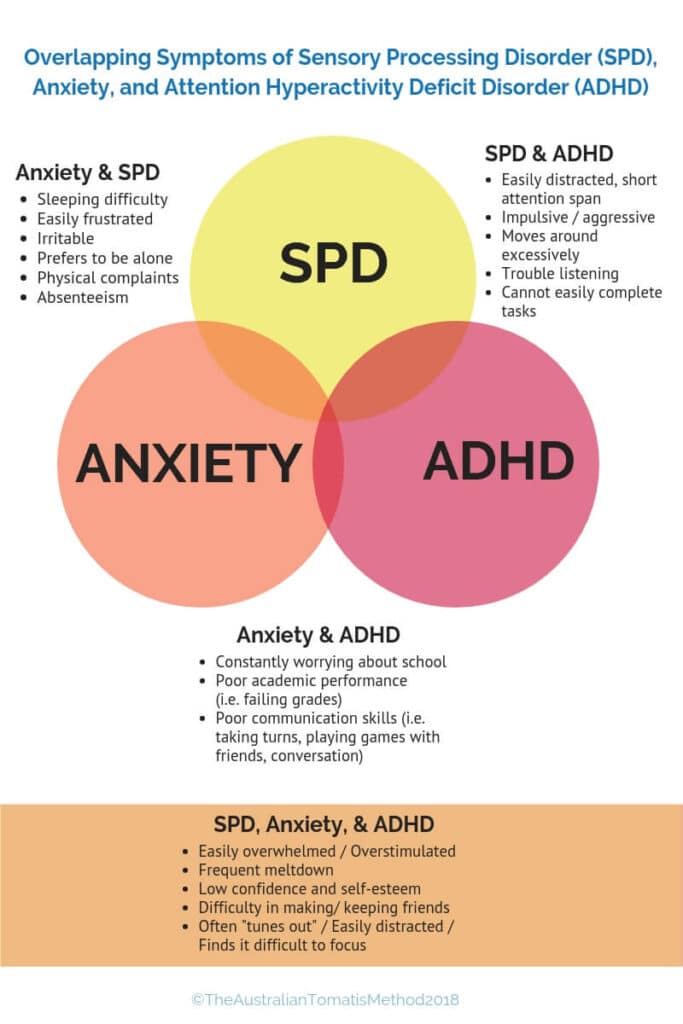
The pattern of poor sensory perception overview is characterized by difficulty in the ability to identify, discriminate, and interpret sensory information in more than one sensory system. Common patterns of SPD are classified as follows: Poor sensory perception overview Somatodyspraxia (SD) Vestibular and bilateral integration deficits (VBID) Visuodyspraxia (VP) and Sensory reactivity (Figure 2). Ayres Sensory Integration Test (Ayres, Citation1977b) and the Sensory Integration and Praxis Test (SIPT) (Mailloux, Citation1990). This classification refers common patterns of SPD derived from studies comparing typically developing children and children with different developmental disorders, including, but not limited to ASD it also includes the Ayres Sensory Integration Assessment Interpretation Tool© (ASI–IT) to interpret patterns (Schaaf & Mailloux, Citation2015). Schaaf (OT, PhD) model can be consulted in her “Clinician´s guide for Implementing Ayres Sensory Integration” (Schaaf & Mailloux, Citation2015). Two of the most widely used are Miller´s and Schaaf´s classifications.ĭr.

Because of its heterogeneity, SPD includes subtypes that are classified according to different models.

This scenario gives rise to a wide variety of symptoms, requiring different treatment strategies depending on the case. SPD is especially difficult to understand and diagnose due to the fact that one or more of the sensory systems could be jointly affected (visual, auditory, tactile, smell, taste, vestibular, proprioception and interoception). Individuals with SPD have impaired responses to, processing of, and organization of sensory information that affects participation in functional daily life routines and activities (Miller et al., Citation2009). In addition, sensory difficulties are a frequent feature in Autism Spectrum Disorder (ASD) and are included in DSM-5 (DSM5 American Psychiatric Association A, Citation2013) as a manifestation within the diagnostic criteria “restricted, repetitive patterns of behavior, interests or activities” (Schaaf & Lane, Citation2015).
SENSORY PROCESSING DISORDER MANUAL
SPD is recognized today as a diagnostic entity in the manual Diagnostic Classification of Mental Health and Developmental Disorders of Infancy and Early Childhood-Revised generally known as Zero to Three (Egger & Emde, Citation2011) and in the Interdisciplinary council on developmental and early disorders (Greenspan & Wieder, Citation2008). The present work aims to provide a general and updated starting point about this disorder, reviewing several important aspects such as assessment, prevalence, related factors and comorbidity, related problems, common signs, candidate biomarkers and treatment. Despite this, a large number of health and educational professionals are still unaware of SPD. SPD may affect learning, coordination, behavior, language or sensorimotor development, among others, hindering daily life activities and occupational participation (Chien et al., Citation2016 Corbett et al., Citation2016 Crozier et al., Citation2016). Sensory Processing Disorder (SPD) (also known as Sensory Regulation Dysfunction, Sensory Integration Dysfunction or Sensory Dysfunction Disorder) can be defined as a condition in which one or more of the SI phases are altered, giving rise to unadapted behavioral and/or motor responses (Galiana-Simal et al., Citation2017).

SENSORY PROCESSING DISORDER REGISTRATION
Some authors divide the SI process in 4 phases (Del Moral Orro et al., Citation2013): registration (the brain receives sensory information from sense organs) modulation (allows the regulation of stimulus intensity) discrimination (the stimulus is organized and interpreted to distinguish its relevance, characteristics and specific qualities) and response (the brain integrates all the processed stimuli to generate an appropriate response that will lead to a particular behavior and movements).

Ayres ( Citation1972), SI is “The neurological process that organizes sensation from one’s own body and from the environment and makes it possible to use the body effectively with the environment”. Anna Jean Ayres (OT, PhD) formulated SI theory through extensive research with children with learning disabilities (Ayres, Citation1977a Ayres & Mailloux, Citation1981). The brain processing of sensory information is called Sensory Integration (SI) and allows reacting effectively to stimuli. These receptors transform the captured stimulus into sensory information that is sent to the brain to be processed, resulting in a determined motor and behavioral response. Sensory receptors capture external stimuli from the environment (through tactile, visual, gustatory, olfactory or auditory receptors) or internal stimuli originated in our own body (via tactile, vestibular or proprioceptive receptors).


 0 kommentar(er)
0 kommentar(er)
